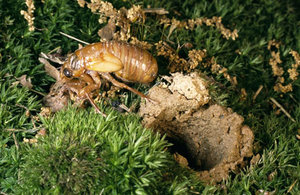After 17 years underground, billions of cicadas are about to descend upon the U.S. Midwest, crowding the trees and filling the air with their distinctive mating call.
But the usually punctual Brood XIII bugs are emerging about a week ahead of schedule - which has some scientists pondering how a changing climate might alter the cicadas' little-understood life cycle.
"The fact that our Aprils are warmer than they have been in the past is apparently encouraging the cicadas to emerge a week or so earlier than they have in the past," said Gene Kritsky, a biologist and cicada expert at the College of Mount St. Joseph in Cincinnati, Ohio.
A Puzzling CycleCicadas in the nymph stage subsist on sap from tree roots. When they emerge as adults - every 13 to 17 years, depending on the brood - they climb trees, shed their skin, and wait for their new exoskeleton to harden.
The adult female cicadas deposit their eggs in the trees. After four to six weeks, nymphs hatch and fall to the soil, where they burrow in for a lengthy stay underground.

|
| ©Darlyne A. Murawski/NGS
|
| Cicadas are crawling out of the ground earlier this year in the U.S. Midwest, prodded, some scientists say, by a warmer spring. It's unknown how the insects' cycles might change in the event of a warmer world.
|
But scientists don't fully understand why the insects follow such a pattern. It may be a species survival behavior: Since there are simply too many for predators to eat, some are able to survive to reproduce.
Climatic TriggersMore is known about the climatic triggers that draw the cicadas aboveground.
"We know that the soil temperatures need to be around 64 to 65 degrees Fahrenheit (about 18 degrees Celsius) for about three to four days before they will emerge," said Daniel Summers, an entomologist at the Field Museum in Chicago, Illinois.
"That is probably the one thing that we do know."
Kritsky of Mount St. Joseph has found that April temperatures guide the cicadas' emergence schedule.
He studied historical emergences and found accurate records for four different appearances dating back to 1885.
"Average April temperatures had a good correlation with emergence - which means temperature increases impact the emergence date," Kritsky said.
Based on April temperature records, Kritsky created a formula that predicts when a brood will appear. So far he has had extremely good results - he nailed the May 14, 2004, emergence of Brood X in Cincinnati and the first appearances of this year's Brood XIII in Chicago.
Kritsky said that he wasn't surprised by this year's early Midwest arrival.
Cicadas in a Warmer WorldIn the event of continuing climate change, the potential impacts to cicadas are unknown.
"If there is something like global warming, what are the direct consequences of that?" the Field Museum's Summers asked.
"One would expect our springs to come earlier."
If the point of optimal soil temperature when cicadas come out is moved up a month, "they will need to adapt or continue to emerge later on when it is much warmer," Summers added.
If a 65-degree-Fahrenheit (18-degree-Celsius) soil temperature is the key, "they may well emerge earlier," he said.
"The question is: How would they adapt to that? Would the trees [on which they depend] be different?"
Cicada broods have altered their cycles in the past, though it's unclear exactly why.
In Illinois in 1969, the insects came out after 13 years rather than 17 years, Summers said, only to return to the 17-year cycle.
Scientists have assumed the switch to a 13-year cycle had something to do with the climate, Summers said.
"It could have been an extremely cold winter, an extremely hot summer - we really don't know," he said. "We don't have enough people out there tracking this."
There will be plenty of golden opportunities to learn more. Although Brood XIII will be history by July, leaving millions of corpses behind, another swarm is imminent.
Next summer, the mid-Atlantic region will brace for Brood XIV.
Reader Comments
to our Newsletter